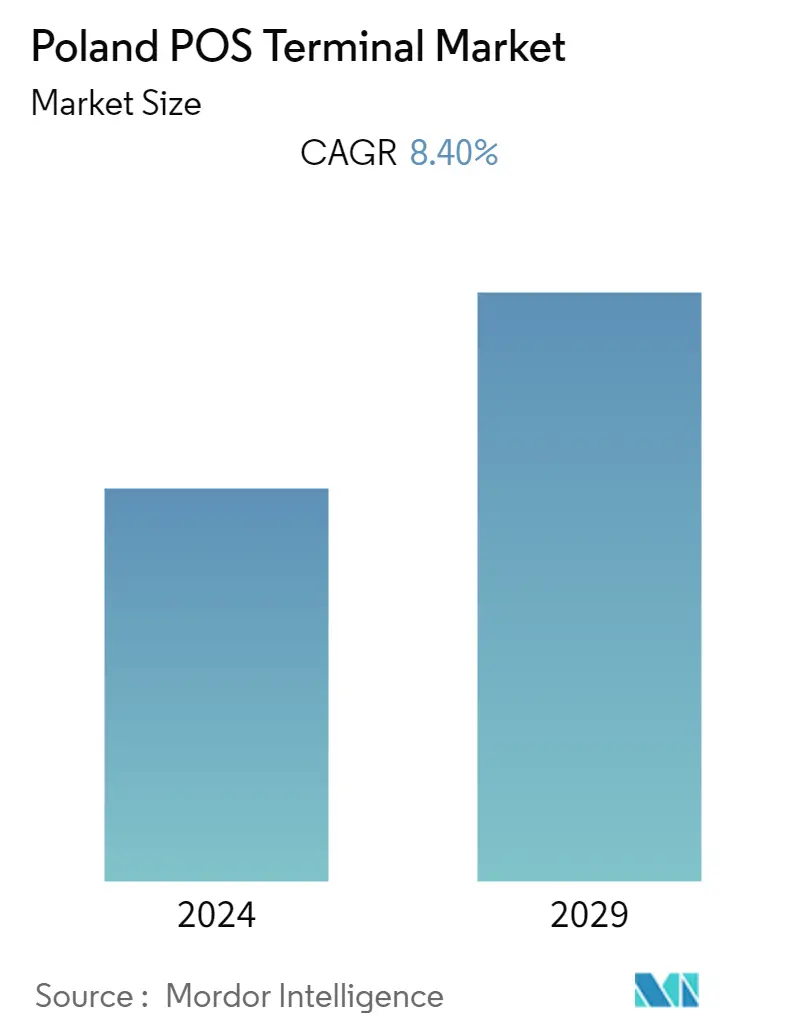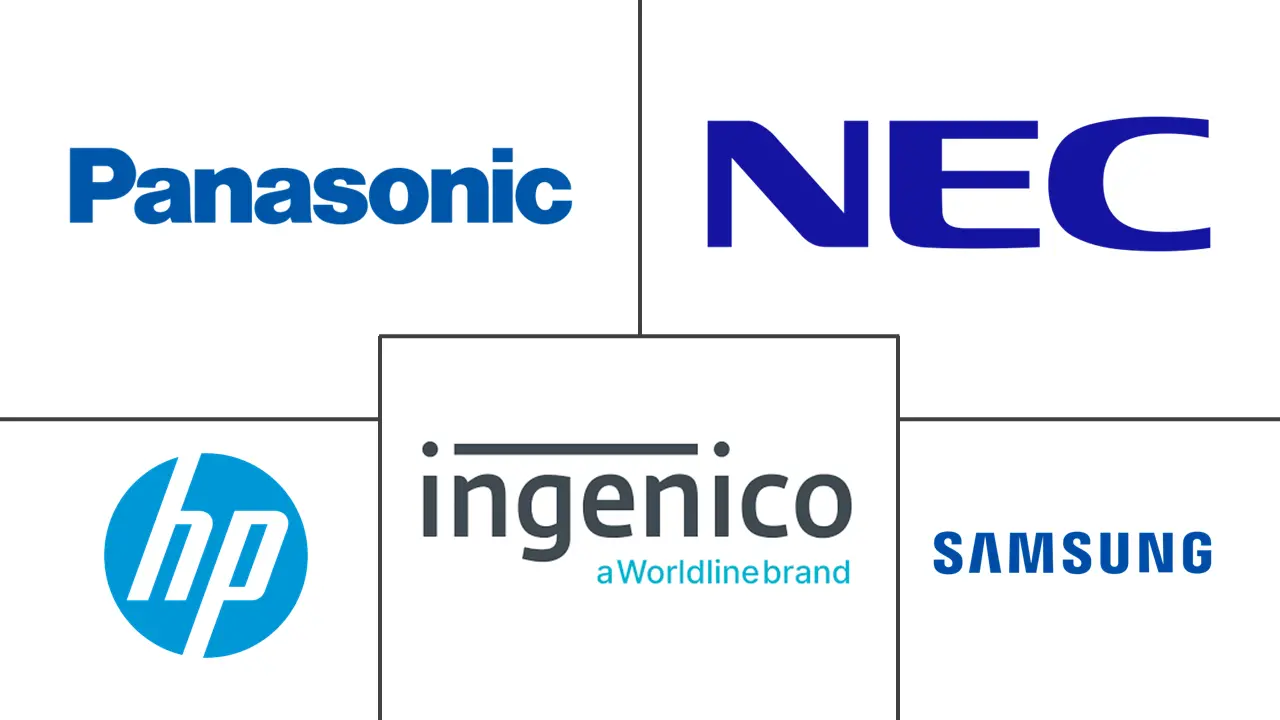Market Size of Poland POS Terminal Industry

| Study Period | 2019 - 2029 |
| Base Year For Estimation | 2023 |
| Forecast Data Period | 2024 - 2029 |
| Historical Data Period | 2019 - 2022 |
| CAGR | 8.40 % |
| Market Concentration | Medium |
Major Players
*Disclaimer: Major Players sorted in no particular order |
Poland POS Terminal Market Analysis
The Poland POS Terminal Market is anticipated to grow with a CAGR of 8.4 % during the forecast period (2022 - 2027). POS terminals are being used extensively for accepting cashless payments and have become a commodity in recent years due to their ease of use.
- The Poland government-sponsored Cashless Poland Program aims to subsidize the cost of POS hardware and merchant service charges for new merchants. The operation has already elevated the number of POS terminals to over 1 million - of which nearly 385,000 were subsidized, with 500,000 more planned to be installed by 2022.
- POS Terminals have been adopted in the country primarily due to favorable government policies, increasing Payment Service Providers (PSPs) in the country, shifting consumer payment behaviors, etc. Mellon Poland, for instance, has over 200,000 POS terminals installed and has been providing customized yet innovative solutions and services across the payment and POS terminals market space. Offering an end-to-end platform supporting all aspects of card Issuing and acquiring services has benefitted allied financial organizations by easing operation in the card market.
- The increase in payments volumes via mobile phones are leading to POS/ECR-dedicated hardware being replaced by all-in-one devices, facilitating card-based payments with PIN on glass or Face-to-Face (F2F) E-commerce payments without an NFC requirement. This could lead to payments through Payment Initiation Service Providers (PISPs) with an easier customer interface for payment methods at merchant vendors.
- There has been a growth in the innovation activities by major players in the market to launch products that support different payment options during COVID-19. For instance, in February 2021, Paydoo, a digital payments provider, partnered with PAX Technology to launch PAX E-series, an all-in-one POS and payment solution for Retail and Hospitality verticals. The E-Series is the first retailer solution to combine cash register and payment terminal powered by Android. It gives merchants full control over their store's operations from one simple, intuitive interface while supporting traditional payments from Chip and Pin, contactless, and QR codes.
- However, several regulations have been passed at the country-level to prevent security breaches in POS terminals. The laws such as the Revised Payment Services Directive (PSD2) and POS security ordinance for the technical security of POS systems help reduce fraudulent activities. The vendors in the market are also upgrading their systems to meet the governmental authorities' regulations, which helps reduce security breaches.
Poland POS Terminal Industry Segmentation
The Poland POS Terminals market tracks the number of terminals across Poland for the period of 2020-2027.
Fixed POS terminals include devices such as PC-based workstations, namely PC-class Processor-based and LAN available terminals. Also, PC on Cash Drawer Devices (PCOCD) and self-checkout (unattended terminals) are part of the scope.
Mobile/Portable devices such as tablets of all sizes and handheld terminals with or without payment processing capabilities are considered. This specific segment caters to the devices used to process a transaction/information. mPOS systems are linked to traditional transaction peripherals, including credit card machines, receipt printers, or scanners, and run on tablets, allowing the user to quickly process a transaction from anywhere on the floor or open a new lane/terminal. Devices are considered with or without credit/debit readers.
The market is further categorized to include end-users across Poland, such as retail, healthcare, hospitality. Also, a detailed COVID-19 impact on the market studied is made part of the study.
| By Type | |
| Fixed Point-of-sale Systems | |
| Mobile/Portable Point-of-sale Systems |
| By End-user Industries | |
| Retail | |
| Hospitality | |
| Healthcare | |
| Others |
Poland POS Terminal Market Size Summary
The Poland POS terminal market is experiencing significant growth, driven by the increasing adoption of cashless payment solutions and supportive government initiatives like the Cashless Poland Program. This program has facilitated the installation of a substantial number of POS terminals by subsidizing costs for new merchants, thereby enhancing the market's expansion. The shift in consumer payment behaviors, coupled with the rise of Payment Service Providers, has further propelled the adoption of POS terminals. Companies like Mellon Poland are leading the charge by offering innovative solutions that integrate card issuing and acquiring services, which streamline operations for financial organizations. The market is also witnessing a transition towards all-in-one devices that support mobile payments, reflecting the growing trend of contactless and mobile payment solutions.
The retail sector is a major contributor to the POS terminal market in Poland, with the reopening of brick-and-mortar stores boosting demand. Retailers are increasingly adopting POS systems to enhance customer retention and streamline operations through features like inventory management and sales reporting. The competition in the retail space is driving the need for advanced POS solutions that can integrate various business functions. Mobile POS systems are gaining traction, offering flexibility and improved customer experiences by enabling transactions at customer locations. The market is moderately consolidated, with key players investing in strategic partnerships and product innovations to capture a larger market share. Recent developments include the introduction of multipurpose Android POS terminals and advanced contactless payment systems, which are set to enhance the payment experience for both merchants and customers.
Poland POS Terminal Market Size - Table of Contents
-
1. MARKET INSIGHTS
-
1.1 Market Overview
-
1.2 Industry Attractiveness - Porter's Five Forces Analysis
-
1.2.1 Bargaining Power of Suppliers
-
1.2.2 Bargaining Power of Buyers
-
1.2.3 Threat of New Entrants
-
1.2.4 Intensity of Competitive Rivalry
-
1.2.5 Threat of Substitutes
-
-
1.3 Industry Value Chain Analysis
-
1.4 Assesment of COVID-19 on the Market
-
-
2. MARKET SEGMENTATION
-
2.1 By Type
-
2.1.1 Fixed Point-of-sale Systems
-
2.1.2 Mobile/Portable Point-of-sale Systems
-
-
2.2 By End-user Industries
-
2.2.1 Retail
-
2.2.2 Hospitality
-
2.2.3 Healthcare
-
2.2.4 Others
-
-
Poland POS Terminal Market Size FAQs
What is the current Poland POS Terminal Market size?
The Poland POS Terminal Market is projected to register a CAGR of 8.40% during the forecast period (2024-2029)
Who are the key players in Poland POS Terminal Market?
Samsung Electronics Corportion Limited, Ingenico Group(WorldLine), HP Development Company LP, Panasonic Corporation and NEC Corporation are the major companies operating in the Poland POS Terminal Market.

